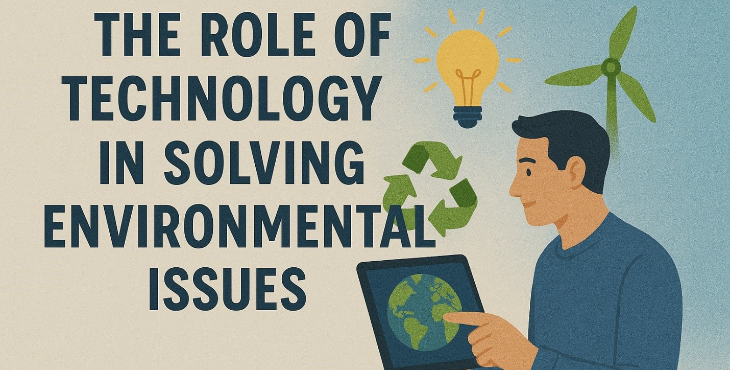
- May 02, 2025
The Role of Technology in Solving Environmental Issues
From rising global temperatures to plastic-filled oceans, the planet is facing serious environmental challenges. But while the problems may be complex, technology is proving to be one of the most powerful tools we have to combat them. Across industries, innovations are helping us reduce pollution, conserve resources, and build a more sustainable future.
Here’s a look at how technology is making a real difference in solving environmental issues—and what the future might hold.
1. Clean Energy Solutions
Fossil fuels are a major source of greenhouse gas emissions. To combat climate change, the world is turning toward cleaner alternatives.
- Solar and Wind Power: These renewable energy sources are becoming more efficient and affordable. Modern solar panels and wind turbines now generate electricity at large scales, reducing reliance on coal and oil.
- Energy Storage: Advanced battery technologies (like lithium-ion and emerging solid-state batteries) are making it possible to store renewable energy for use when the sun isn’t shining or the wind isn’t blowing.
- Smart Grids: These systems use data and automation to distribute electricity more efficiently and reduce waste.
2. Sustainable Agriculture
Feeding a growing population without harming the environment is a major challenge—but technology is helping:
- Precision Farming: GPS-guided tractors and data-driven tools allow farmers to use just the right amount of water, fertilizer, and pesticides—minimizing waste and environmental impact.
- Vertical Farming and Hydroponics: These methods grow crops indoors using less space and water, and without the need for soil.
- Drones and Sensors: These tools help monitor crop health and detect issues before they become widespread, improving yield and sustainability.
3. Pollution Reduction and Waste Management
Technology is also helping reduce pollution and manage waste more efficiently:
- Plastic Alternatives: New materials like biodegradable plastics and plant-based packaging are reducing our reliance on harmful, non-degradable plastics.
- Recycling Innovations: AI-powered sorting systems are improving recycling rates by accurately separating materials in recycling facilities.
- Water Purification Technologies: Advanced filters and desalination systems are making clean water more accessible, especially in areas facing drought or contamination.
4. Conservation and Biodiversity
Protecting the natural world requires better data—and technology delivers.
- Satellite Imaging and Drones: These tools help track deforestation, illegal fishing, and wildlife populations in real-time.
- AI for Wildlife Monitoring: Artificial intelligence can analyze camera trap photos to identify species and track animal movements, helping conservationists protect endangered species.
- 3D Printing: Used to create artificial reefs and restore damaged ecosystems, 3D printing is becoming a valuable tool for environmental restoration.
5. Green Transportation
Transportation is another big source of pollution—but change is on the horizon:
- Electric Vehicles (EVs): From cars to buses and even planes, EVs are reducing carbon emissions and dependence on fossil fuels.
- Bike-Share and Public Transit Tech: Apps and smart transit systems are making it easier for people to choose greener travel options.
- Alternative Fuels: Hydrogen fuel cells and biofuels are being explored as eco-friendly options for long-distance transportation.
6. Smart Cities and Sustainable Design
Urban areas can benefit greatly from tech-based sustainability solutions:
- Smart Buildings: Equipped with energy-efficient systems, these buildings automatically adjust lighting, heating, and cooling to reduce energy usage.
- Green Architecture: Designs that incorporate green roofs, solar panels, and eco-friendly materials help cities reduce their carbon footprint.
- Waste-to-Energy Systems: These systems convert trash into usable energy, reducing landfill waste and generating power at the same time.
Final Thoughts
Technology alone won’t solve all our environmental problems—but it gives us powerful tools to tackle them more effectively and efficiently. As innovation continues, it’s up to governments, businesses, and individuals to support and adopt these solutions for a greener, cleaner future.
The future of our planet depends not just on invention, but on action. And technology gives us the opportunity to act smarter.


